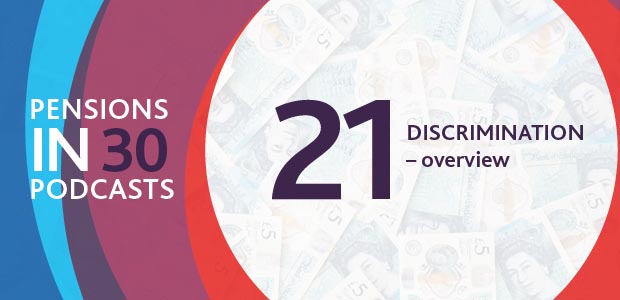The first of four podcasts focusing on discrimination, episode 21 of Pensions in 30 Podcasts provides an overview of UK laws and looks discrimination in the pension context.
 Subscribe
Subscribe
Download the fact sheet here.
Key points
- The Equality Act 2010 prohibits direct discrimination and indirect discrimination on the grounds of a protected characteristic.
- The protected characteristics listed in the Equality Act 2010 are sex, age, religion or belief, race, sexual orientation, gender reassignment, pregnancy & maternity, marriage and civil partnership, and disability.
- With the exception of age, direct discrimination cannot be objectively justified, but indirect discrimination can be.
- There are particular exemptions in the Equality Act 2010 and associated regulations that apply to pension schemes, notably in relation to age.
- Trustees of occupational pension schemes are liable to their members or prospective members if they discriminate in terms of the offer of membership or benefits provided under the scheme, for example.
- All occupational pension schemes are deemed to include a non-discrimination rule, regardless of what the rules say.
- The Equality Act 2010 also applies (with certain important exceptions) to providers of goods and services.
Main sources
- The EC Equal Treatment Framework Directive 2000/78
- The Equality Act 2010
- The Equality Act (Age Exceptions for Pension Schemes) Order 2010 (SI 2010/2133)
Background
The UK's discrimination laws mainly originate from Europe, and in particular, the EC Equal Treatment Directive 2000/78 (framework for equal treatment in employment and occupation), EC Directive 2002/73/EC (Equal treatment for men and women as regards access to employment, vocational training and promotion, and working conditions), and EC Race Discrimination Directive 2000/43.
The Equality Act 2010 implements these directives in Great Britain. The relevant provisions of the Equality Act 2010 came into force on 1 October 2010 and the Equality Act 2010 consolidated and added to the majority of discrimination provisions in the UK that had previously been contained in various separate strands of primary and secondary legislation.
In addition to the Equality Act 2010, the Fixed-term Employees (Prevention of Less Favourable Treatment) Regulations 2002 (SI 2002/2034) and the Part-time Workers (Prevention of Less Favourable Treatment) Regulations 2000 (SI 2000/1551) exist to protect fixed-term employees and part-time workers from less favourable treatment.
The Equality Act 2010
The Equality Act 2010 prohibits direct discrimination, indirect discrimination, harassment and victimisation against individuals on the grounds of a 'protected characteristic.' Those protected characteristics are sex, age, religion or belief, race, sexual orientation, pregnancy & maternity, gender reassignment, marriage and civil partnership, and disability.
Direct discrimination applies where a person treats a person less favourably than another because of a protected characteristic. For example, if a participating employer, or the trustees of an occupational pension scheme, told its female members that they would be receiving a lower accrual rate than men, this would be direct discrimination.
Indirect discrimination applies where a person applies a seemingly neutral provision, criterion or practice which puts people who have a protected characteristic at a particular disadvantage when compared with people who do not share that characteristic. For example, if a participating employer stated that only full-time employees could join its pension scheme, this would be likely to be indirect sex discrimination because more women tend to work part-time hours than men. This provision would also fall foul of the Part-time Workers (Prevention of Less Favourable Treatment) Regulations 2000 unless it could be objectively justified.
Harassment and victimisation are less likely to arise as pension-specific claims (although this could change as a result of the seeming increase in pension liberation cases).
In the case of all protected characteristics apart from age, direct discrimination cannot be justified.
Indirect discrimination however can be justified (and will not be unlawful) if the employer/trustee can show that the provision, criterion or practice in question is a proportionate means of achieving a legitimate aim.
There has been a large volume of case law establishing what this means in practice.
Overview of discrimination in the pension context
The Equality Act 2010 is relevant to employers in the way they treat their employees, and the benefits they provide to them, including pensions.
However, it is not just employers who are liable. Trustees of occupational pension schemes can also be liable if they discriminate against members, or prospective members.
Section 61 of the Equality Act 2010 implies a non-discrimination rule into occupational pension schemes. This is overriding and establishes the principle that a responsible person must not discriminate in carrying out any of the functions in relation to the scheme, or harass or victimise another in relation to the scheme. Responsible persons include the trustees or managers of the scheme and actual and prospective participating employers.
Section 62 of the Equality Act 2010 effectively gives the Trustees of an occupational pension scheme an overriding power, by resolution, to make "non-discrimination alterations" to their scheme rules i.e. to amend the rules so that they are non-discriminatory. This, by resolution, power is available where the trustees do not have the power to amend and make such changes under the rules or where using the procedure for doing so would otherwise be "liable to be unduly complex or protracted" or "involves obtaining consents which cannot be obtained or which can be obtained only with undue delay or difficulty."
In addition to the duties applying to Trustees and employers, the Equality Act 2010 also applies (with important exceptions) to the providers of goods and services.
The common types of discrimination that need to be considered
The following types of discrimination are most likely to need consideration by trustees of an occupational pension scheme:
- Age;
- Fixed term employees;
- Part-time workers;
- Sex;
- Civil Partnership; and
- Sexual orientation.